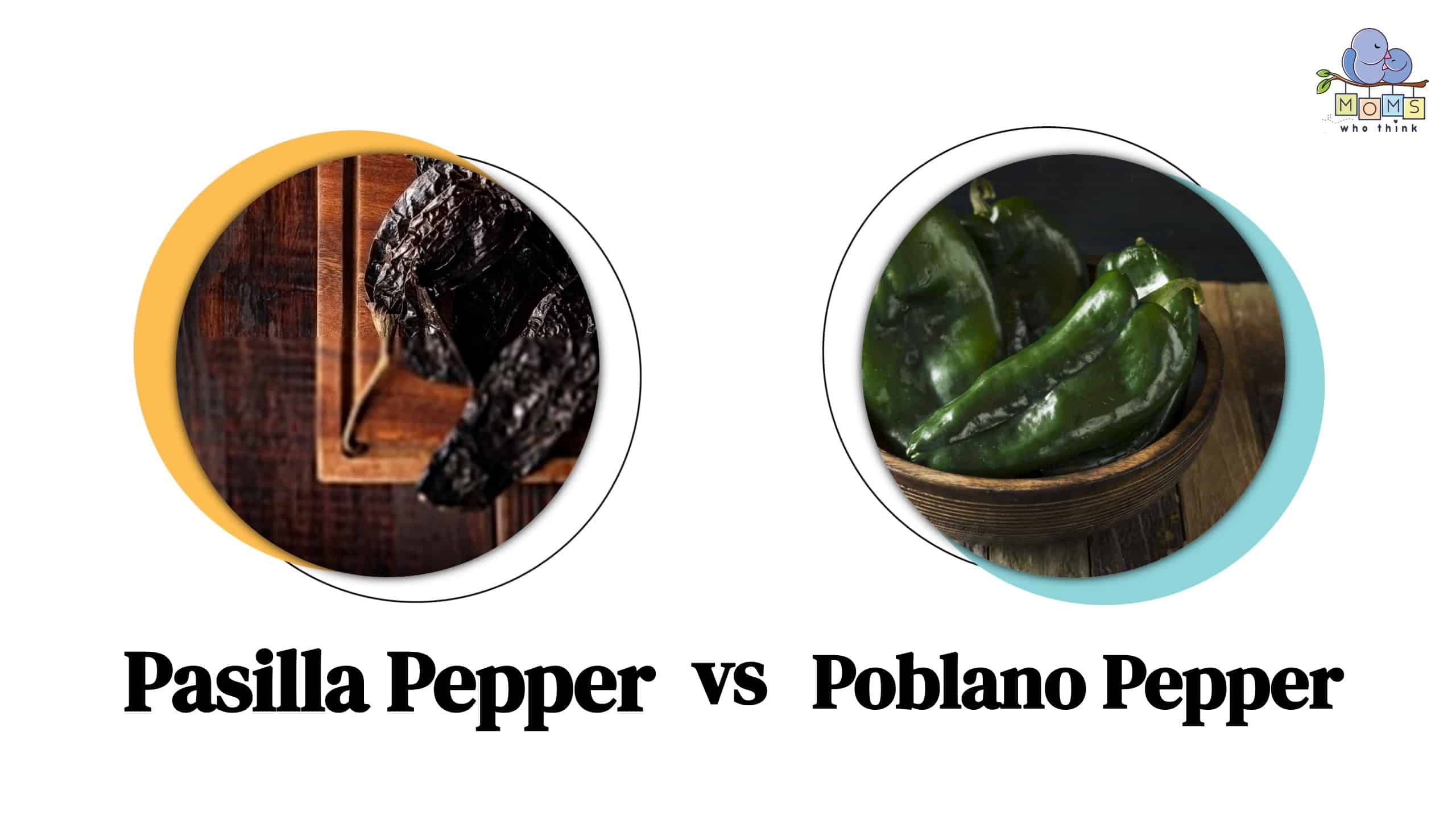There are thousands of different peppers around the world, and with such a large variety to choose from it can be overwhelming to figure out which pepper is best suited for your next culinary dish. So, what is the difference between pasilla pepper vs. poblano? A pasilla pepper also known as chili negro, is a small, thin chili and is normally sold dried. Poblano on the other hand is larger and looks like a bell pepper.
In this article, we will explore the key differences between pasilla pepper vs. poblano, their origins, heat intensities, nutritional values, and recipes. By the end, we hope that you will have a better understanding of the differences between these two peppers.
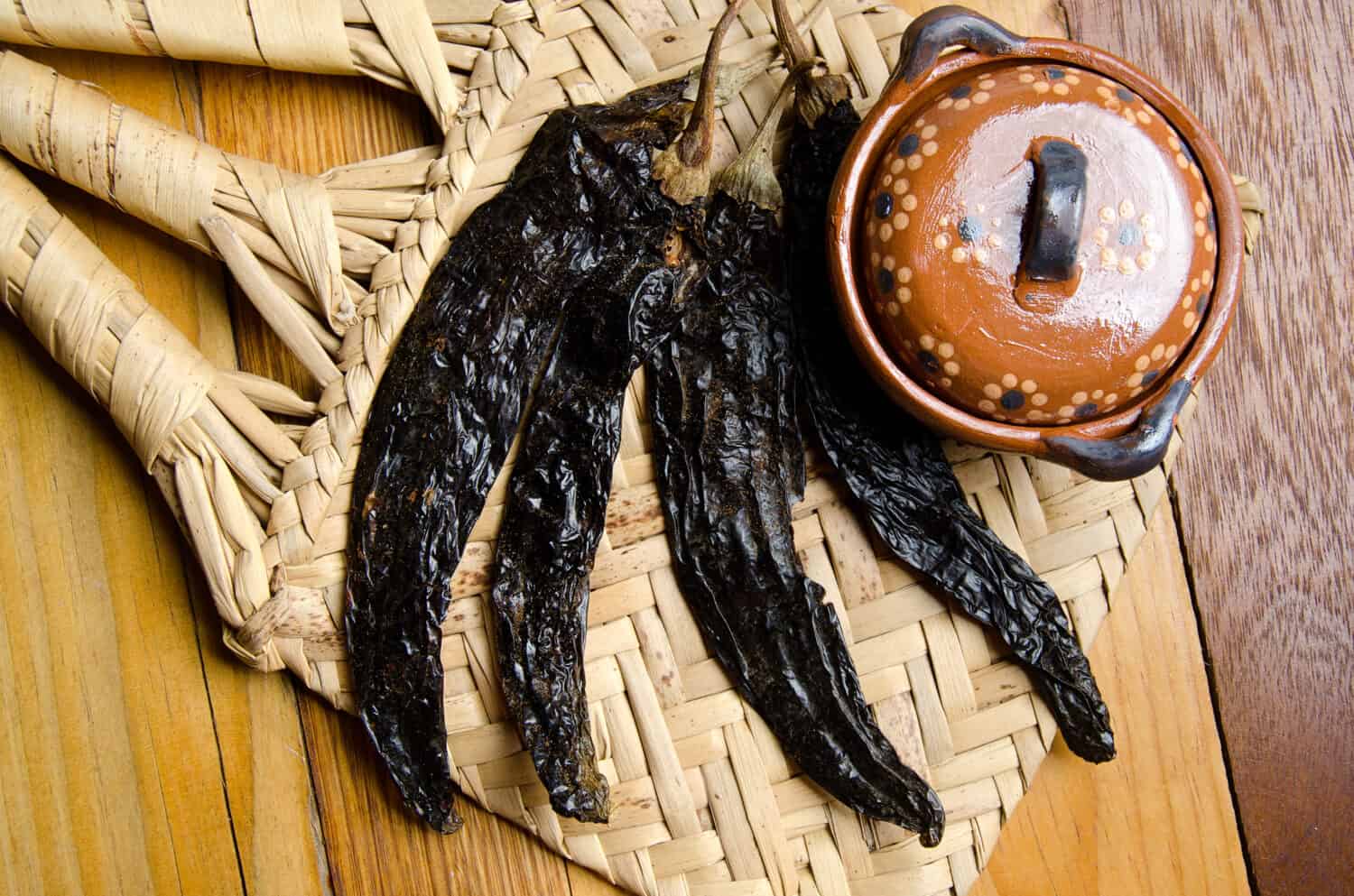
©Guajillo studio/Shutterstock.com
Pasilla Pepper vs. Poblano: What Is the Difference?
The first key difference is that poblano is usually sold fresh and pasilla is typically sold dried. The second difference is that pasilla peppers are long, thin, and reddish-dark brown with wrinkled skin. Pasilla chilis are about 6-8 inches long and 1-1/2 inches wide.
Poblano peppers are dark green, larger, and look like bell peppers. Once fully ripe they are approximately 4 inches long and 2 inches wide making them a perfect pepper to stuff.
Where Do Pasilla Peppers vs. Poblano Peppers Originate?
Both peppers originate from Mexico in the valley of Puebla. Today they are one of the most popular peppers in Mexico and around the world.
Nutritional Values
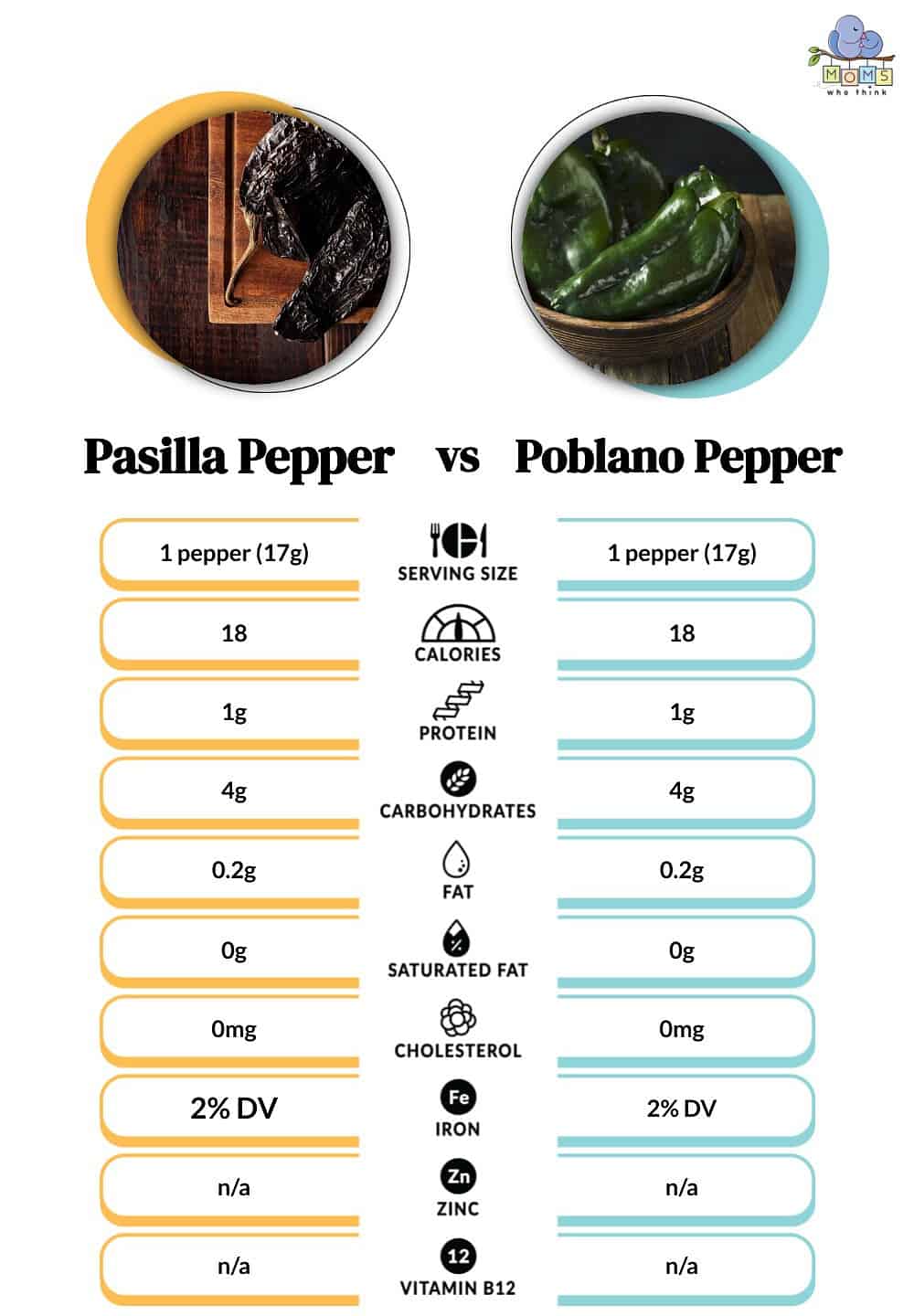
©
Capsaicin in peppers has been proven to have anti-cancer traits that could be helpful in weight loss and inflammation. These peppers contain many minerals and vitamins that can help benefit the body. Let us take a closer look at the health benefits of these tasty peppers.
- Weight: 17g
- Calcium: Reduces the risk of osteoporosis. Osteoporosis often affects women after menopause when calcium and estrogen levels are low. This causes the bones in the body to become brittle. Taking calcium also reduces the risk of high blood pressure.
- Iron, Fe: The body needs iron for growth and development and creates the proteins myoglobin, which oxygenates the muscles, and hemoglobin, which is found in red blood cells and sends oxygen from the lungs to all areas of the body.
- Potassium K: Can reduce blood pressure, improve muscle movement, and maintain water retention.
- Magnesium: Supports nerve and muscle function. Low levels of magnesium in the body can increase the risk of high blood pressure and type 2 diabetes.
- Phosphorous, P: The body uses phosphorous to make protein for maintaining and repairing cells and tissues.
- Sodium: Helps maintain the proper balance of water, minerals, and the transmission of nerve impulses.
- Zinc, Zn: This is an essential mineral that helps maintain blood clotting, thyroid function, and the immune system. The RDA (recommended daily allowance) for women over 19 years is 8mg per day and 11mg for men.
- Manganese: Supports normal nerve and brain function. It regulates the blood sugar and helps the body to form connective tissue and sex hormones.
- Selenium: Boosts your immune system and improves your nails and hair. People with certain types of cancer often have low levels of selenium.
Vitamins
- Vitamin A: Supports healthy eyes and boosts your immune system. Vitamin A also improves your skin and can reduce wrinkles.
- Vitamin C: Not only is vitamin C excellent for fighting colds and flu it also helps your body to store and absorb iron.
- Riboflavin (B2): Reduces inflammation of the nerves and stress. It plays a significant role in maintaining the body's energy supply. Riboflavin (B2) is also known to reduce migraines. Taking 400mg per day is known to be the perfect dose to prevent migraines.
- Niacin (B3): This is an important nutrient needed for the body to function properly. Symptoms of niacin defiance include skin rash or discoloration, bright red tongue, constipation or diarrhea, fatigue, vomiting, headaches, and memory loss. It may reduce blood pressure and improve blood fat levels. Again it also improves brain function and may help lower cholesterol. Niacin is water soluble which means that the body does not store it. The body uses what it needs, and the access exits the body when you urinate.
- Vitamin B5 (PA): This plays a vital role in breaking down carbohydrates and fats for energy. It is important for the production of red blood cells in the body, as well as hormones related to stress and sex.
- Vitamin B6: Keeps the immune and nervous systems healthy. Foods that contain vitamin B6 include bananas, potatoes, and fish.
- Folate (B9): Folate plays a key role in our overall health. It is necessary to produce red blood cells which send oxygen through the body. Folate is an important vitamin that pregnant women should take as it helps repair and build DNA. It is recommended that pregnant women should take at least 400mg of folate or folic acid before and up to 12 weeks during their pregnancy. Taking folate can prevent neural tube birth defects such as Spina bifida which affects the spine.
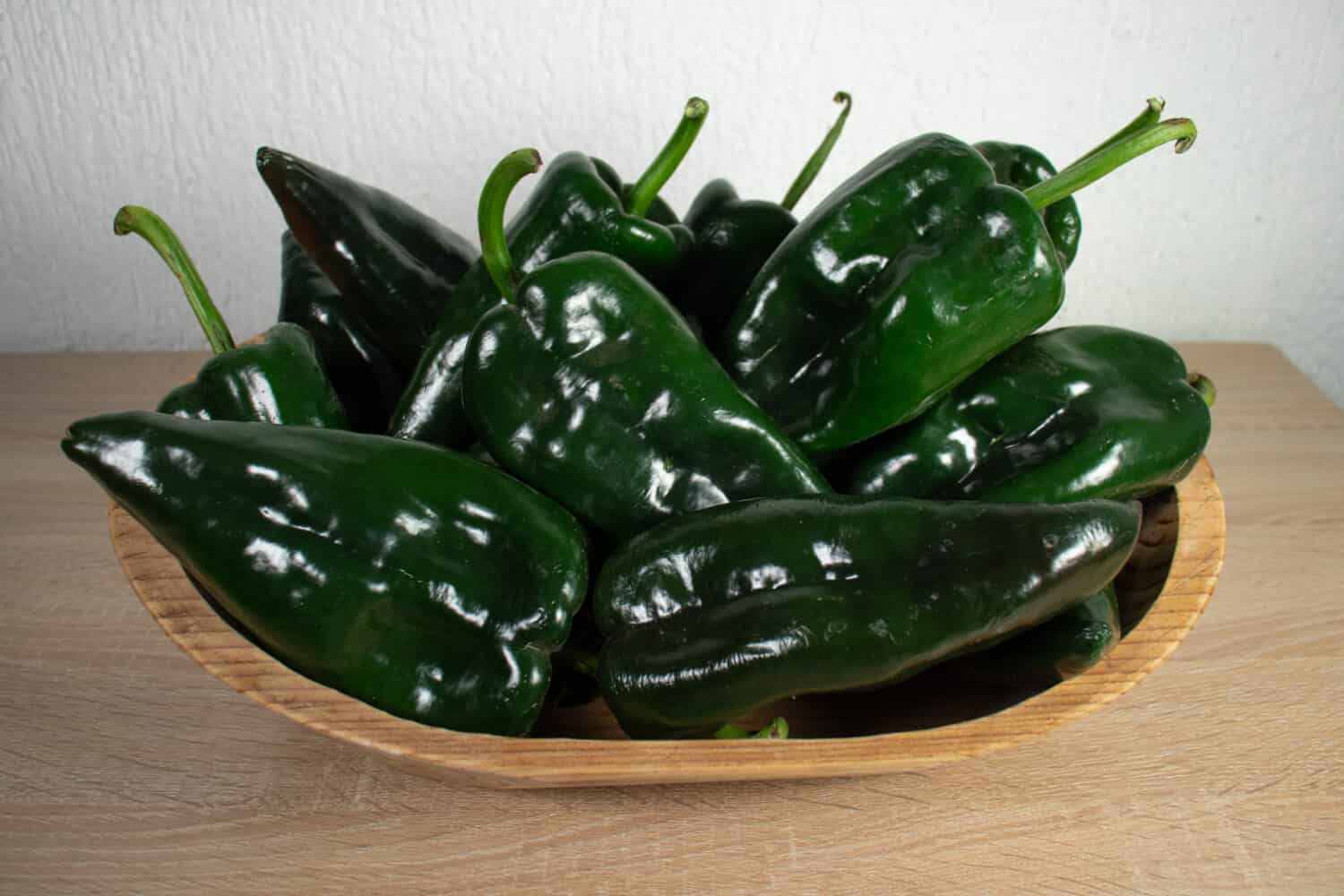
©OScar HMz/Shutterstock.com
What Are Pasilla Peppers Used for and How Hot Are They?
These peppers are used mostly in Mexican cuisines such as salsas, enchilada sauce, mole sauce, and soups. Their unique taste and flavor can enhance any dish. They have a mild to medium heat level and an earthly flavor which can add a little kick to your dish. According to the Scoville scale, the pasilla pepper heat unit ranges between 1000 and 2000.
Top 3 Dishes to Make With Pasilla Peppers
- Cauliflower cheesecakes in Chile pasilla sauce: To make the cakes you will need cauliflower, flour, grated queso fresco (white Mexican cheese), salt, egg, cilantro, onion, and oil. For the sauce, you will need dried pasilla peppers, tomatoes, onion, garlic, vegetable or chicken stock, and olive oil.
- Chili pasilla pork rinds: Who doesn’t like the deliciousness of salty pork rind? What a crowd-pleaser. All you need is pasilla peppers, water, green tomatoes, garlic, onion, oil, and pork rinds cut into strips.
- Pasilla mole sauce: Dried pasilla peppers, chopped tomatoes, onion, garlic, chicken broth, toasted sesame seeds, raisins, cloves, pepper, cinnamon, coriander, and bittersweet chocolate.
What Are Poblano Peppers Used for and How Hot Are They?
Poblano peppers are typically used in traditional Mexican cuisine where they are stuffed with meat and cheese then dipped in a batter and deep fried. These peppers have a delicious smoky flavor and can be roasted, or added to stews, soups, and salsas. In the same way as the pasilla pepper, poblano peppers share the same heat level between 1000 and 2000.
Top 3 Dishes to Make With Poblano Peppers
- Chili Relleno (stuffed peppers): Roasted poblano peppers, Monterey Jack or cheddar cheese, oil, eggs, all-purpose flour, and salt. For the salsa roja, tomatoes, garlic, onion, jalapeño, cilantro, kosher salt, and olive oil.
- Smoky poblano corn pudding: Poblano peppers, milk, heavy whipping cream, white sugar, all-purpose flour, butter, eggs, kosher salt, frozen corn, cheese, and chopped chives.
- Creamy poblano mac and cheese: Butter, onion, red bell pepper, tomato garlic salt pepper Campbell’s Condensed Creamy Poblano & Queso Soup, milk, cheese, macaroni, and cilantro.
Conclusion
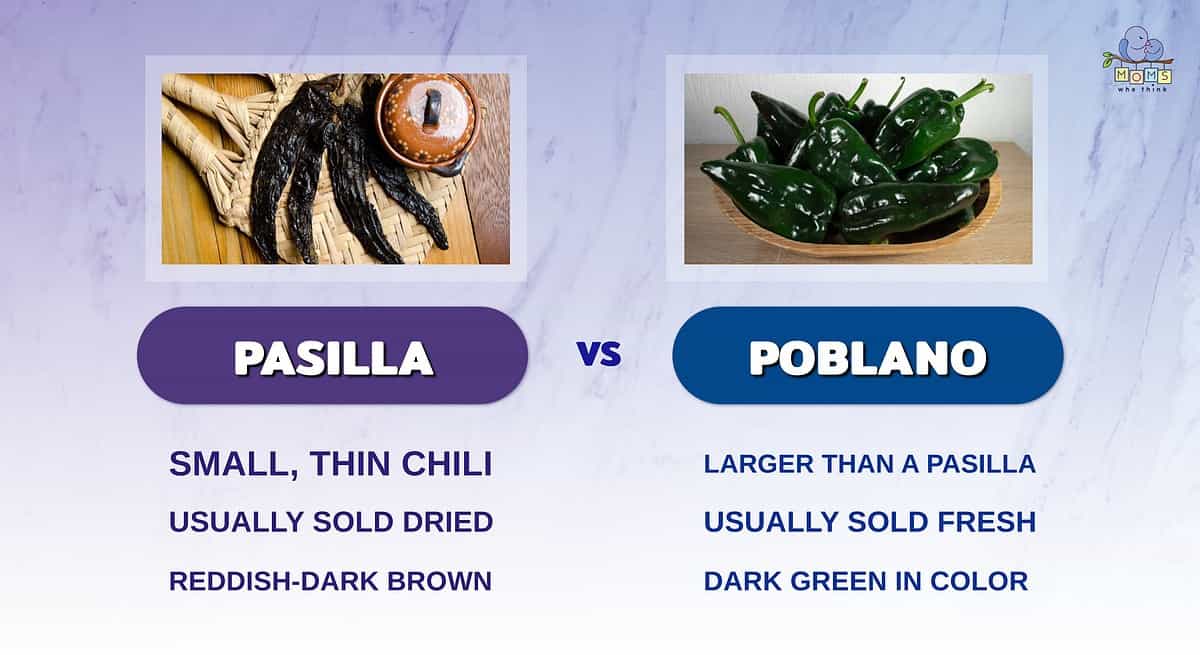
- Pasilla peppers are small and thin, while poblanos are larger. It's important to note this distinction when thinking about how many you may need for a recipe.
- Poblanos are generally sold fresh, while a pasilla pepper will be dried before sale.
- It's a good idea to know the differences in color between these two peppers. Pasilla peppers are reddish-dark brown in color, while pablanos are dark green. By knowing this difference, you can easily tell them apart in the store.
To sum up, both pasilla and poblano peppers have found their way into many international dishes. They are used in pasta, soups, and sauces adding that extra flavor. They are also a reliable source of vitamin C and other antioxidants. If you are looking to add a touch of heat to your recipes, poblano, and pasilla peppers are a wonderful choice to consider.
FAQs
Can I substitute pasilla for poblano?
While both of these peppers have a similar SHU level and mild flavor it is perfectly fine to substitute either one. It all depends on your preferences.
Can I grow pasilla and poblano peppers at home?
It is best to start growing your seedlings indoors for the first 5 weeks. Place them in well-drained soil. When possible, avoid compressed soil because it can cause water to sit for too long which will damage the roots.
How long do pasilla vs. poblano peppers take to grow?
These peppers take 65-80 days and prefer temperatures of 70 to 90°F.
Recipes
When hunger strikes, try one of these tasty and quick meals:
Print
Ham with Red Potatoes
Ingredients
1–1/2 pounds red potatoes, peeled and sliced
8 ounces thinly sliced ham
2 poblano chile peppers, cut into thin strips
2 tablespoons olive oil
1 tablespoon dried oregano leaves
1/4 teaspoon salt
1 cup shredded Monterey Jack, or Pepper-Jack cheese
2 tablespoons finely chopped fresh cilantro
Instructions
1. Combine all ingredients except cheese and cilantro in slow cooker; mix well.
2. Cover; cook on low 7 hours .
3. Transfer ham-potato mixture to serving dish; sprinkle with cheese and cilantro. Let stand 3 minutes or until cheese melts.
